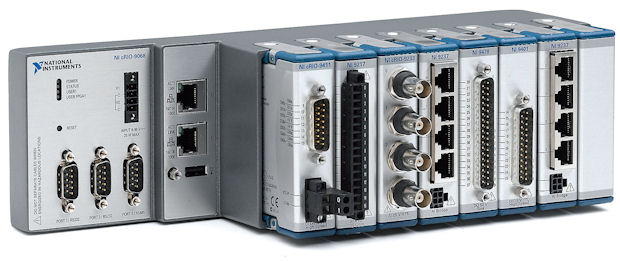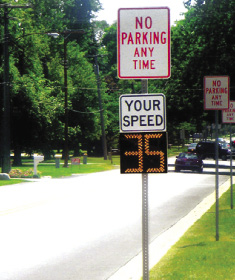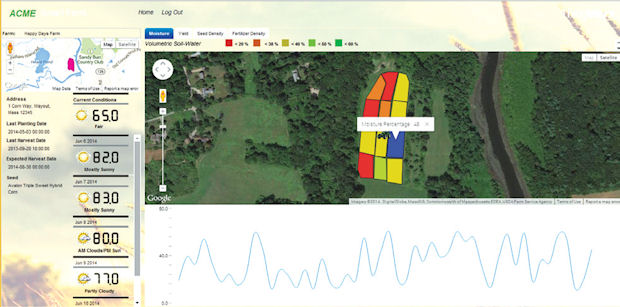
National Instruments’cRIO-9068 controller, programmed with LabVIEW system design software, enables engineers to use a single, graphical development environment to build and test cyber-physical systems. Image courtesy of National Instruments.
Latest News
August 1, 2014
 National Instruments’cRIO-9068 controller, programmed with LabVIEW system design software, enables engineers to use a single, graphical development environment to build and test cyber-physical systems. Image courtesy of National Instruments.
National Instruments’cRIO-9068 controller, programmed with LabVIEW system design software, enables engineers to use a single, graphical development environment to build and test cyber-physical systems. Image courtesy of National Instruments.The Internet of Things (IoT) is the latest trend being hyped by analysts and prognosticators as having disruptive potential—so much so that it’s prompting product design and engineering organizations to ramp up new competencies, and requiring manufacturers to rethink and transform their business models.
IoT generally refers to what some call the next-generation Internet, where physical objects are connected via the standard Internet Protocol (IP). Anything from cars to industrial machines to medical devices can be involved—even people and livestock. Using an array of embedded sensors, actuators and a variety of other technologies, these loosely connected “things”can sense aspects of their environment and communicate that information over wired and wireless networks, without human intervention, for a variety of compelling use cases.
Consider the potential of IoT in terms of remote diagnostics. A tractor, for example, could be outfitted with sensors that collect data about its operation in the field, providing real-time insights into performance and proactively flagging part failures before they actually occur. From a service perspective, that real-time data can provide a technician with everything he or she needs to know about how to address a particular problem, to be properly prepared with the right parts and equipment before going on-site to resolve it. Finally, all of the failure and performance data can be fed back into internal product development systems, giving engineering teams valuable insights that can drive future product generations.
That’s just a start. Beyond product development and manufacturing, experts see huge potential for the IoT to help tackle many of the global society’s thorniest problems, including climate change, urban congestion and health care. IoT is already playing a role in orchestrating more efficient energy usage via the rise of smart grids, facilitating highly coordinated disaster response efforts. IoT is also the brains behind the new sci-fi crop of autonomous vehicles, from the Google Car to unmanned drones.
A New Economy
Big-picture, visionary applications aside, there’s already significant IoT momentum thanks to the explosive growth of tablets and smartphones. Cisco estimates that there will be 25 billion devices connected to the Internet by 2015, and 50 billion by 2020. This sets the stage for a sea change in types of products and IoT applications brought to market. In addition, a recent McKinsey Global Institute report predicts that 80% to 100% of all manufacturers will be using IoT applications by 2025, and the IoT has the potential to unleash as much as $6.2 trillion in new global economic value annually by 2025.
Industry watchers are projecting entirely new business models springing up around the IoT. In this new world, companies aren’t just selling physical products, but rather the subscription services built around these next-generation products.
“Smart and connected products raise the bar on design, and smartness opens up a whole new world of possibilities in delivering value through services,”Jim Hepplemann, CEO of PTC, told PTC Live 2014 conference attendees in June.
PTC is betting big on the IoT, having doled out $112 million last year to purchase ThingWorx, which makes an application platform for building IoT applications (see “PTC Rolls out ThingWorx v5.0,”page 15). This is in addition to PTC’s earlier acquisition of MSK Integrity, which focuses on software lifecycle management capabilities, and more recently, Atego, a developer of model-based systems and engineering (MBSE) applications.
“The fact that we are trying to keep our strategy refreshed and relevant speaks to the complexity and sophistication of products right now,”Hepplemann said. “You need lot of different talents to get one of these smart connected things out the door, but you can’t not make them smart and connected. If you don’t, you’ll be a dinosaur.”
Four IoT Competencies for Design Engineers
Building smart and connected products designed to live in the world of IoT will require engineering organizations to master some new areas, and also get better at competencies that have been around awhile, like multi-disciplinary and systems engineering. While there’s lots of talk about the potential of IoT, and most analysts agree about its significance for the future, it’s still early days in terms of companies making wholesale changes to their product development and engineering processes. That’s according to Stan Przybylinski, vice president of research for CIMdata, a market research firm specializing in engineering.
“We’re not really seeing it yet,”he admits. “There’s a lot of people out there talking, but there isn’t a lot of action. People are still having problems doing basic stuff.”
Companies committed to pushing their products to the next level need to consider the following four disciplines as part of an IoT engineering makeover:
1 Embedded software is fast becoming a staple of all kinds of physical products, not just cars and airplanes. With the IoT fast approaching, there is no turning back. Mechanical engineers need to interface regularly with software specialists so both design aspects of the product evolve concurrently. This is preferred over a siloed approach, which can often introduce problems later in the game, when it’s more costly to address.
The level of software expertise is also critical for IoT development. “It’s got to be a higher level of software knowledge, as opposed to programming,”says Jim Tung, MATLAB Fellow at MathWorks. “It’s important to have software architect skills while programming skills become less important.While software skills have been a priority for many engineering organizations for some time, some traditional shops are still lacking in this area, according to CIMdata’s Przybylinski.
“Software has been a creeping incompetence for a lot of companies as it’s found its way into products,”he explains. “A lot of the issues you see in products out in the field now can be attributed to the increased role that software plays, and its ability to throw people off their game.”
2 Communication capabilities become a critical part of the design, with devices and products of all sorts connecting to the Internet to interface with other “things”(Editor’s Note: For more on this, see “Simulating M2M System Communication,”page 24). Engineers will need to choose from dozens of proprietary and standard communications protocols, and factor in things like network protocols, potential radio frequency (RF) noise and interference, and the physical fit and placement of new communication components as part of their requirements-gathering and formal design processes.
“Mechanical and electromechanical design teams now have to think about communications as a first-class citizen in the design process, and consider it as another set of domain constraints in what is now multi-domain system design,”MathWorks’Tung explains.
3 Instrumentation is crucial to leverage the data collected by a smart product to institute a change (like remote programming a new function) or to initiate proactive service. First, though, the design team needs to understand how the device is to behave in the field so it can be properly outfitted with sensors to collect the right information.
Understanding the functional aspects of how the equipment is to behave will help design engineers anticipate potential failure modes much more effectively, which in turn effects how they spec the instrumentation into the design, explains Brian Thompson, vice president for Creo Product Management at PTC. At this stage, the design team needs to discern what types of sensors make the most sense for the product, and the kind of data they’re trying to collect.
“Engineers should be working with field and service teams to ensure the instrumentation strategy covers all the bases,”Thompson says. “Customers are only now just starting to think about this.”
4 Data and security should be at the heart of any IoT-enabled product. After all, the data collected will have some sort of impact on the design, whether it’s to make a change to its functionality via a software update, or to feed back into internal product development systems to direct future design iterations. Securing that data is equally important.
As a result, IT, typically the domain that has ownership of data, needs to be brought into the engineering fold so they have some sensitivity to the system design aspect of the actual devices or “things”that will be physically harvesting and responding to that data. There are also new latency and data security aspects to consider—again, areas that fall outside of the traditional domain expertise of most design engineers.
“Engineers can’t be building devices in isolation if they want to take advantage of the possibilities,”notes Ray Almgren, vice president of marketing at National Instruments. “It can bring in a whole other set of challenges, because your device is going to be getting data or serving up data to some database, and that information can be acted upon automatically without human intervention to make better decisions.”
Case in Point
 All Traffic Solutions leveraged PTC’s ThingWorx rapid application development platform to retool its street signs for the smart and connected world of IoT. Image courtesy of All Traffic Solutions.
All Traffic Solutions leveraged PTC’s ThingWorx rapid application development platform to retool its street signs for the smart and connected world of IoT. Image courtesy of All Traffic Solutions.All Traffic Solutions, a manufacturer of smart traffic signs, went down the path of IoT-enabled products almost five years ago—and hasn’t looked back. Initially, the company’s first- and second-generation smart signs, which are primarily marketed to municipalities, collected data on traffic and speed profiles, but it had to be manually downloaded from the physical sign using a traditional serial cable and eventually a portable device. Today, the third-generation signs collect data and serve it up to an Internet-based database. This not only allows for easier access, but also makes it possible to deliver robust searching and analytical capabilities, according to All Traffic Solutions President Ted Graef.
The company’s engineering group had to master a number of new competencies, however, including beefing up knowledge of antennas and other communications elements. The signs incorporate a modem, which raised numerous design challenges trying to get an off-the-shelf cellular modem into the sign’s already optimized footprint.
“It was a case of not letting the guts of the unit drive what the unit looks like or how it ends up functioning,”explains Graef. “We had to work hard to get everything in the same package we were already using for the non-connected product.”
More than any challenge to engineering, the real work came with reorienting the entire organization around IoT and transitioning the business model to be less about selling signs and more about marketing subscription services.
“The real message is that IoT is not an engineering project, it’s a business project,”Graef concludes. “Connectivity is a business process, not a technology. You have to get set up so you can take advantage of the product’s connection so you can monetize it. Because if you’re not monetizing it, why are you doing it?”
Beth Stackpole is a contributing editor to Desktop Engineering. You can contact her at bethmailto:[email protected].
More Info
Subscribe to our FREE magazine, FREE email newsletters or both!
Latest News
About the Author
Beth Stackpole is a contributing editor to Digital Engineering. Send e-mail about this article to [email protected].
Follow DE






